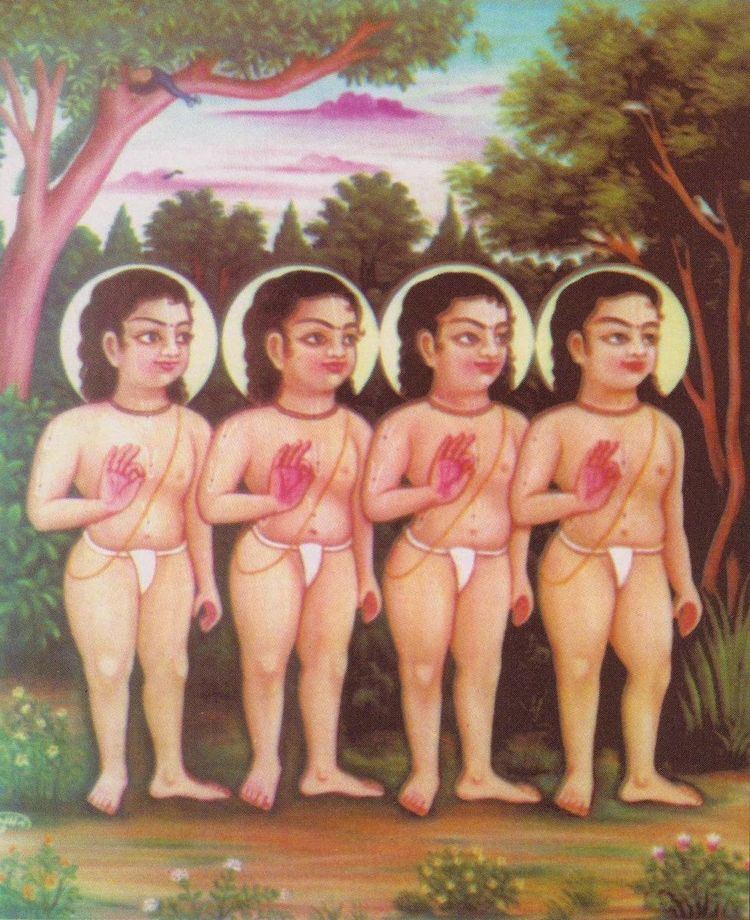Abode Janaloka | ||
 | ||
Affiliation Rishi, Avatar of Vishnu | ||
Sage Sanatkumara was one of the Four Kumaras, the four Manasputras (mind-born-sons) or spiritual sons of Brahma according to Puranic texts of Hinduism, including the Bhagavata Purana, whose other sons were Sanaka, Sanatana, and Sanandana. Sanatkumara in Sanskrit means "eternal youth". Though in Mahabharata, total seven sons are mentioned, namely: Aniruddha, Sana, Sanatsujata, Sanaka, Sanandana, Sanatkumara, Kapila, and Sanatana and further mentions that,"Knowledge comes to these seven rishis, of itself (without being dependent on study or exertion). These seven are wedded to the religion of Nivritti (inward contemplation). They are the foremost of all persons conversant with Yoga. They are possessed also of deep knowledge of the Sankhya philosophy. They are preceptors of the scriptures on duty and it is they that introduce the duties of the religion of Nivritti (inward contemplation), and cause them to flow in the worlds".
Contents
He is also the author of the Sanatkumara Samhita, which is part of the Shiva Purana, and has 59 chapters. It is also taken as a part of the Pañcaratra, Vaishnavite devotional texts.
The Chandogya Upanishad, Chapter seven, is about Sanatkumara's Instructions on Bhuma-Vidya to celestial sage Narada, Sanatkumara finds mention across Mahabharta, as a great sage, who dispels doubts and the preceptor in all matters affecting Yoga
Also mentioned is the Tirtha of Kanakhala near Gangadwara or Haridwar, where through extensive tapas, he attained great ascetic powers.
Sanatkumara as Lord Karthikeya
Boudhayana Kalpa Sutra and Taittiriya Upanishad states that Sage Sanatkumara appeared as Lord Subrahmanya, also known as Lord Muruga in south, due to the request of Lord Shiva and Goddess Parvati. Lord Muruga is one of six main Deities of Hindu.
Legend of Jaya and Vijaya
Bhagavata Purana mentions the story of the Four Kumaras, visiting Vaikuntha, the abode of Vishnu, where his gate keepers, Jaya and Vijaya, stop them, taking them to be children, as due to their 'tapas', the Four Kumaras, looked like children or eternally young; upon which the four Kumaras cursed them to take birth on earth, as human beings.
As the legend continues, Vishnu intervened and offered them the option of taking three births as his enemy, whereupon they would be restored to their former position.
Subsequently, in Satya Yuga, they were born as Hiranyakashipu and Hiranyaksha, to Diti (daughter of Daksha) and Kasyapa. Lord Vishnu undertook the Varaha Avatar to kill Hiranyaksha, and the Narasimha avatar to kill Hiranyakasipu.
In the second life, during the Treta Yuga, they were born as Ravana and Kumbhakarna and defeated by Rama avatar as mentioned in the epic Ramayana. Finally, in their third and final life in Dwapara Yuga, they were born as Sishupala and Dantavakra during the time of Krishna avatar, also mentioned in epic Mahabharatha.
